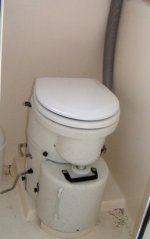The waste system on your boat consists of three main parts. Toilet, a holding tank, and a macerator pump, plus a couple of sub parts.
I am assuming you have a manual head and not a vacuflush model. The head has a manual pump and a lever that in one position is pumping in sea water (or fresh water if you are in fresh water) to actually flush the head into the holding tank, and the other position will not introduce water, but empty the rest of the contents of the bowl into the tank. You should have already added about 8 oz of a holding tank deodorizing liquid to the tank via the toilet. If you are on a trailer you can add water to the bowl manually. This should keep the odors in check. The water comes throught an through hull opening on the bottom of the boat which also has a valve on it which must be open. It is under the step as you enter the cabin. Usually you pump a little water into the bowl, do your business and then pump more water with the hand pump until you have emptied the bowl. Then switch the lever and finish emptying the bowl. Everything you just pumped will go to the holding tank, which is about 24 gallons. You should be using marine type toilet paper and not household type. Marine paper disintegrates much faster.
You can see the level in the tank visually. The tank on a 25 is dead center under the motor well. There are two options for emptying the tank. Pump-out stations which are at most marinas and are free usually. This involves putting a vacuum looking hose and nozzel into the WASTE outlet on your port rear gunnel and when actuated will basically suck out the contents of the tank into the pumpouts receiving tank. Rubber gloves are a good thing to carry for the task.
The macerator pump is only used when discharging the contents of the holding tank directly into the body of water you are in. In the US this can only legally be done in open water and several miles away from land. Can't remember the actual distance. In other words you can never use the macerator pump and discharge into any lake or stream or for example anywhere in Puget Sound or the San Juans. You would have to go out into open ocean several miles.
In Canada you can discharge into open waters, but not in bays or inlets etc. So for example you can't discharge on the US side of the International Border, but if you go a a little distance into Canada you can.
Back to the macerator pump. There is an outlet valve on the discharge side of the pump which by law must be kept closed when in US waters. This is against the port side and accessed throught the port floor hatch. If the CG does a boat check on you and it is found in the discharge position you can get a sitation. So keep it closed always. You should not run the macerator pump with that valve closed as that could burn out the pump. You do not use the macerator pump at a pump out station.
If you are using a good deoderant of the proper amount for your tank size you shouldn't get any smell when flushing as it is a closed system. ( Assuming you have the discharge valve closed.) You should only need to pump out when the tank is nearing full and then you would need to add more deoderant.
Hope this is helpful.
After looking at most of your posts I now find you have a Kingfisher. So the locations of valves are not accurate for your boat.
e went with an aluminum pilot house called a Kingfisher. "Fishin is the Mission" with Jeff and I wanted a little bit of comfort. This boat seems to be a great happy medium for both of us.

